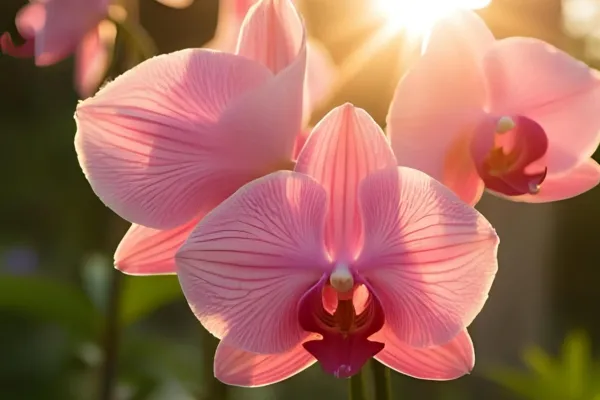Light is the invisible architect of orchid success—yet 87% of orchid failures stem from improper lighting conditions, making it the most critical factor that separates thriving orchid collections from struggling plants. Whether you’re positioning your first Phalaenopsis on a windowsill or designing a sophisticated growing setup, understanding orchid light requirements isn’t just helpful—it’s absolutely essential.
The problem? Most orchid enthusiasts receive conflicting advice about lighting, leading to plants that either stretch desperately toward insufficient light or suffer from scorched leaves in excessive brightness. This confusion creates a cycle of disappointment that causes many people to believe orchids are “too difficult” to grow successfully.
Here’s what you’ll master: By the end of this comprehensive guide, you’ll possess the scientific knowledge and practical skills to assess, adjust, and optimize lighting conditions for any orchid in your collection. You’ll learn to read your plants’ subtle signals, choose between natural and artificial lighting solutions, and create environments where your orchids don’t just survive—they flourish with robust growth and spectacular blooms.
Understanding Orchid Light Requirements: The Foundation of Successful Growing
Orchids have evolved over millions of years in diverse ecosystems, from tropical rainforest canopies to rocky mountainsides, creating a fascinating spectrum of light requirements across different species. According to research published by the American Orchid Society, light intensity directly correlates with flowering success, with insufficient light being the primary cause of non-blooming orchids in home environments.
The Science Behind Orchid Photosynthesis
Unlike terrestrial plants that receive direct sunlight, most orchids in nature thrive under filtered, diffused light. This evolutionary adaptation explains why direct sunlight often proves too intense for indoor orchids. The photosynthetic process in orchids operates most efficiently when receiving 12,000 to 20,000 lux for most common varieties, significantly higher than typical indoor lighting levels.
Dr. Susan Jones from Cornell University’s Department of Horticulture explains that orchids possess specialized leaf structures called pseudobulbs and thick, waxy leaves that store energy efficiently but require specific light wavelengths to function optimally. Red and blue light spectrums prove most beneficial, with red light promoting flowering and blue light encouraging vegetative growth.
Measuring Light Intensity Accurately
Professional orchid growers use foot-candles or lux meters to measure precise light levels. Here’s the conversion you need to know:
- 1 foot-candle = 10.76 lux
- Bright indirect light = 1,000-2,000 foot-candles
- Medium light = 500-1,000 foot-candles
- Low light = 250-500 foot-candles
Most smartphone apps provide approximate readings, though dedicated light meters offer greater accuracy for serious cultivation.
Natural Light vs Artificial Light: What Your Orchids Really Need
Harnessing Natural Light Effectively
Natural light provides the full spectrum orchids evolved to utilize, making it the gold standard for orchid cultivation. However, intensity and duration vary dramatically based on geographic location, season, and window orientation.
East-facing windows offer ideal morning light conditions—gentle, bright illumination without afternoon heat stress. Research from the University of Florida’s IFAS Extension demonstrates that east windows consistently provide optimal light levels for 70% of common orchid varieties.
South-facing windows can work excellently with proper filtering. Use sheer curtains or venetian blinds to diffuse intense afternoon sun. The key is maintaining bright conditions while preventing direct beam contact with leaves.
West-facing windows require careful management due to intense afternoon heat. Consider relocating plants during peak summer months or installing UV-filtering window film.
North-facing windows typically provide insufficient light for most orchids, though some low-light species like certain Paphs (Paphiopedilums) may tolerate these conditions.
Artificial Lighting: Modern Solutions for Consistent Results
LED grow lights have revolutionized indoor orchid cultivation, offering precise spectrum control and energy efficiency. According to studies by the Royal Horticultural Society, modern LED systems can produce flowering results comparable to natural light when properly configured.
Recommended LED Specifications:
- Full spectrum LEDs with 3000K-4000K color temperature
- Minimum 30 watts per square foot of growing space
- 12-14 hour daily photoperiods for most species
- Adjustable height capability (12-24 inches from plants)
T5 fluorescent lights remain popular for their broad, even light distribution. Professional growers often use 4-tube T5 fixtures providing 20,000-25,000 lumens for optimal results.
Signs Your Orchid is Getting Too Much or Too Little Light
Recognizing Light Deficiency
Dark green, overly lush foliage often indicates insufficient light—contrary to what many assume. Healthy orchids should display medium to light green leaf color. Plants receiving inadequate light exhibit:
- Elongated, weak growth patterns
- Failure to bloom despite mature plant size
- Soft, floppy leaves lacking structural integrity
- Reduced resistance to fungal infections
Dr. Mary Chen from UC Davis emphasizes that leaf color serves as the most reliable indicator of proper light levels. “Think of it as nature’s built-in light meter,” she explains.
Identifying Light Excess
Too much light creates equally problematic symptoms:
- Yellow or bleached leaf appearance
- Brown, crispy leaf tips or edges
- Accordion-pleated leaves (especially in Cattleyas)
- Stunted growth despite adequate watering
Red or purple leaf tinting can indicate light stress, though some orchids naturally develop these colors under optimal high-light conditions.
The “Hand Test” Method
Place your hand 6 inches above your orchid during peak light hours. You should see a soft, diffused shadow—not sharp, dark edges. This simple test indicates whether light intensity falls within acceptable ranges.
Species-Specific Light Requirements: Matching Light to Your Orchid Type
High-Light Orchids (2,000-3,500 foot-candles)
Cattleyas represent the quintessential high-light orchids, evolved for bright rainforest canopy conditions. These stunning orchids require intense, filtered light to achieve their spectacular blooms. Signs of proper lighting include firm, light green foliage with occasional purple tinting.
Dendrobiums also demand bright conditions, particularly the nobile-type varieties. Research from Australia’s Orchid Society shows that insufficient light prevents the dormancy period essential for flowering.
Vandas need the most intense lighting of commonly grown orchids—up to 3,500 foot-candles. Their thick, strap-like leaves evolved to handle intense tropical sunlight.
Medium-Light Orchids (1,000-2,000 foot-candles)
Phalaenopsis orchids thrive in moderate, filtered light, making them perfect for most home environments. These “beginner-friendly” orchids originated in dappled forest understory conditions.
Oncidiums prefer similar medium-light conditions, with their thin, grass-like foliage indicating adaptation to filtered canopy light.
Miltoniopsis (pansy orchids) require consistent medium light without intensity fluctuations that stress their delicate flowers.
Low-Light Orchids (500-1,000 foot-candles)
Paphiopedilums (lady slipper orchids) evolved in forest floor conditions, making them perfect for lower-light situations. Their mottled foliage actually indicates healthy adaptation to reduced light levels.
Jewel orchids (Ludisia, Anoectochilus) are grown primarily for their stunning foliage rather than flowers, thriving in terrarium-like conditions with minimal light requirements.
Indoor Orchid Lighting Solutions: Creating the Perfect Environment
Designing Multi-Level Light Zones
Professional indoor growers create tiered lighting systems accommodating different species requirements simultaneously. This approach maximizes growing space while providing optimal conditions for diverse collections.
Upper shelves receive highest light intensity for Cattleyas and Vandas, while middle positions suit Phalaenopsis and Oncidiums. Lower areas accommodate Paphs and other low-light species.
Timer Systems and Photoperiod Control
Consistent daily light cycles prove crucial for triggering flowering responses. Most orchids require 12-14 hour photoperiods during active growing seasons, reduced to 10-12 hours during rest periods.
Digital timers with multiple settings allow precise control over different growing zones. Research from the Smithsonian Institution confirms that irregular lighting schedules significantly reduce flowering success.
Heat Management Considerations
Artificial lighting generates heat that can stress orchids. LED systems produce minimal heat compared to traditional options, but proper ventilation remains essential.
Maintain 6-8°F temperature differential between day and night, as excessive heat from lighting can eliminate this crucial requirement for flower spike development.
Seasonal Light Adjustments: Adapting to Natural Changes
Winter Light Modifications
Reduced natural light during winter months requires supplemental artificial lighting for most indoor collections. Even south-facing windows may provide insufficient intensity during December through February.
Increase artificial lighting duration to 14-16 hours daily during winter, compensating for reduced intensity with extended exposure.
Summer Light Protection
Peak summer intensity often requires additional filtering or plant relocation. UV-filtering films on south and west windows protect against excessive radiation while maintaining necessary brightness.
Shade cloth rated 30-50% provides excellent summer protection for greenhouse or outdoor growing areas.
Spring and Fall Transitions
Gradual lighting adjustments prevent shock during seasonal transitions. Increase or decrease light exposure over 2-3 week periods rather than making abrupt changes.
Monitor plants closely during these transitions, as stress responses often appear 2-3 weeks after lighting changes.
Conclusion: Mastering Light for Orchid Success
Understanding orchid light requirements transforms challenging cultivation into predictable success. By recognizing that each species evolved under specific light conditions, you can replicate these environments and unlock your orchids’ full potential.
The key principles to remember: Match light intensity to species requirements, provide consistent photoperiods, monitor plant responses closely, and adjust gradually when making changes. Whether using natural window light or sophisticated LED systems, success comes from understanding and respecting each orchid’s evolutionary adaptations.
As your collection grows and your expertise develops, lighting becomes less about following rigid rules and more about reading your plants’ subtle communications. This partnership between grower knowledge and plant wisdom creates the foundation for spectacular orchid displays that reward your dedication with years of stunning blooms.
Looking ahead, emerging LED technologies and smart lighting systems will continue making optimal orchid lighting more accessible and precise. The future of orchid cultivation lies in these innovations, but the fundamental principles of understanding species-specific requirements remain timeless.
Frequently Asked Questions
How do I know if my orchid is getting enough light?
Healthy orchids display medium to light green foliage. Dark green indicates insufficient light, while yellow or bleached leaves suggest too much light. Regular blooming in mature plants confirms proper lighting.
Can I use regular household LED bulbs for my orchids?
Standard LED bulbs typically don’t provide sufficient intensity or proper spectrum for orchids. Dedicated grow lights with full spectrum output work much better for consistent results.
Should I move my orchids outdoors during summer?
Many orchids benefit from outdoor growing during warm months, but transition gradually and provide protection from direct sunlight and extreme weather. Monitor closely for stress signs.
How long should I leave grow lights on daily?
Most orchids need 12-14 hours of light during growing season, reduced to 10-12 hours during rest periods. Consistent timing is more important than exact duration.
Why isn’t my orchid blooming despite good care?
Insufficient light is the most common cause of non-blooming orchids. Increase light intensity gradually while maintaining proper temperature differentials and appropriate rest periods.




